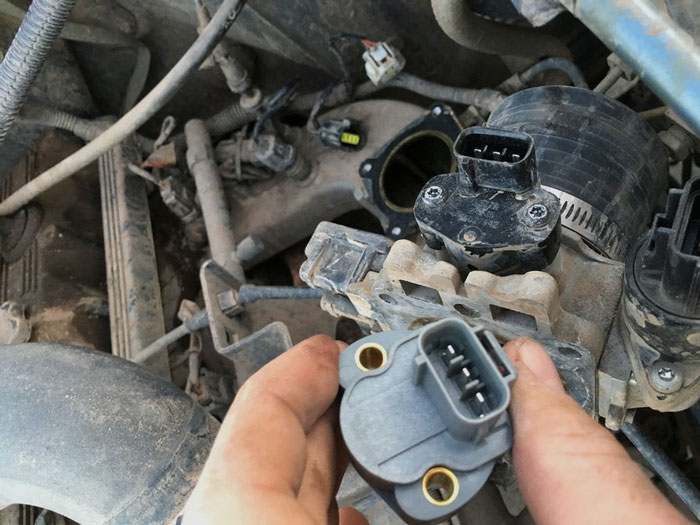So, picture this: you’re cruising down the road in your trusty Jeep Wrangler, wind in your hair, tunes blasting, living your best life. But suddenly, out of nowhere, your ride starts acting up. Is it possessed by some off-road gremlin? Nope, it might just be your throttle position sensor throwing a tantrum.
Ever experienced your Jeep feeling a bit moody, hesitating when you hit the gas, or maybe even stalling unexpectedly? Well, my fellow adventure-seeker, these could be signs that your throttle position sensor is up to no good. But fear not, we’re diving into the world of Jeep Wrangler throttle position sensor symptoms to help you decode these mysterious car shenanigans.
Buckle up, Jeepers! We’re about to unravel the quirky signals your Wrangler might be sending you, courtesy of that mischievous little sensor. Let’s navigate through the wild terrain of symptoms together and get your ride back to its smooth-sailing, off-roading self in no time.
Understanding the Throttle Position Sensor in Jeep Wrangler
Hey there, fellow Jeep enthusiasts! Let’s jump into the world of throttle position sensors and uncover the secrets behind these quirky little devices in our beloved Jeep Wranglers.

What Is a Throttle Position Sensor?
Ah, the mystical Throttle Position Sensor (TPS). This magical gizmo is like the Jedi Knight of your Jeep’s engine, sensing how hard you press that accelerator pedal. It’s the Sherlock Holmes of the automotive world, always on the hunt for clues about your driving intentions.
How Does the Throttle Position Sensor Work?
Picture this: You’re cruising down the road, wind in your hair, when suddenly, the TPS whispers to the engine control unit (ECU), “Hey, they’re stepping on it!” The ECU then commands the engine to give you that boost you crave. It’s like having your own personal speed genie, granting your wish for more power.
Common Symptoms of a Faulty Throttle Position Sensor
Ah, the enigmatic throttle position sensor – a little gremlin that can wreak havoc in your Jeep Wrangler if not kept in check. Let me walk you through the telltale signs that this mischievous sensor might be up to no good.
Erratic Engine Behavior
Picture this: you’re cruising along in your trusty Jeep, enjoying the ride, when suddenly, it starts acting like a toddler on a sugar rush – jerky acceleration, random stalling, and an overall moodiness that rivals your least favorite aunt. If your Wrangler starts behaving like a rebellious teen, it might just be the throttle position sensor acting out.
Poor Fuel Economy
We all love a good fuel-efficient ride, but if your Jeep Wrangler starts chugging gas like it’s going out of style, the throttle position sensor could be the culprit. It’s like having a leaky faucet – except instead of water, it’s your hard-earned money dripping away with every mile you drive. Keep an eye out for sudden drops in fuel efficiency; your wallet will thank you.
Difficulty in Shifting Gears
Shifting gears is usually a seamless dance between you, your Wrangler, and the open road. But when the throttle position sensor decides to throw a tantrum, gear shifts can feel more like a clunky, awkward prom dance where nobody knows the steps. If you find yourself struggling to shift gears smoothly or experiencing delays, it’s time to investigate that sneaky sensor.
To conclude, if your Jeep Wrangler starts exhibiting any of these symptoms – erratic behavior, fuel-guzzling tendencies, or shifting struggles – don’t ignore the signs. Get that throttle position sensor checked out before it turns your smooth ride into a bumpy rollercoaster of automotive woes.
Diagnosing Throttle Position Sensor Problems
Hey there, fellow Jeep enthusiasts! Wondering how to tackle those pesky throttle position sensor issues? I’ve got your back. Let’s jump into the fun world of diagnosing these problems together.
Tools Needed for Diagnosis
First things first, let’s gather our detective tools to crack the case of the misbehaving throttle position sensor:
- OBD-II Scanner: Think of this as your trusty sidekick, helping you communicate with your Jeep’s inner workings.
- Multimeter: Your electronic detective kit isn’t complete without this tool to measure electrical values accurately.
- Basic Toolkit: A set of standard tools will come in handy for any surprises along the way.
Now that we have our gear ready, let’s move on to the exciting part!
- Scan for Trouble Codes: Plug in your OBD-II scanner and see what insights it reveals about the sensor’s performance.
- Voltage Testing: Time to get electric! Use your multimeter to check the voltage output of the throttle position sensor.
- Visual Inspection: Sometimes, a good ol’ visual check can unveil loose connections or damages that might be causing the issues.
- Check for Resistance: Put your multimeter to work again to test the sensor’s resistance levels for any irregularities.
- Wiggle Test: Yes, you read that right! Give those wires a gentle wiggle to see if there’s any intermittent connection disruption.
- Compare Readings: Compare your findings with manufacturer specifications to spot any deviations.
- Reset Adaptations: Sometimes, resetting the Jeep’s adaptations can help relearn sensor values and improve performance.
Replacing the Throttle Position Sensor
Ah, the time has come to swap out that finicky Throttle Position Sensor in your Jeep Wrangler. Let’s get down to it and make sure our ride behaves like a charm.
Necessary Tools and Materials
Here’s what you’ll need to tackle the TPS replacement job:
- Socket wrench set (because who doesn’t love some wrenching?)
- New Throttle Position Sensor (the star of this show)
- Clean cloth (for that touch of elegance)
- Electrical contact cleaner (to give those connections a spa day)
- Torque wrench (for that extra bit of… torque)
- Once-over glance at your Jeep (because, hey, who doesn’t like to admire their ride?)
Installation Steps
Time to roll up those sleeves and get our hands dirty (figuratively, of course):
- Disconnect the Battery: Safety first, folks. Let’s make sure we’re not zapping ourselves during this adventure.
- Locate the Sensor: Track down that sneaky sensor near the throttle body. It’s time to say goodbye to the old and hello to the new.
- Unplug and Remove: Gently unplug the sensor’s electrical connector and remove the mounting screws. Out with the old!
- Clean the Area: A quick clean-up never hurt anyone. Wipe down the area before installing the fresh sensor.
- Install the New Sensor: Pop in the new sensor, secure it with the mounting screws, and reconnect the electrical connector. Easy-peasy!
- Reconnect the Battery: Time to reunite the battery with its rightful place. Let there be power!
- Test Drive: The best part—take your Jeep for a spin. Feel the difference a new sensor makes!
Frequently Asked Questions
Should I replace the throttle body or the sensor?
In newer vehicles, the throttle position sensor is integrated into the throttle body. If the sensor malfunctions, the entire throttle body needs replacing.
What happens if I disconnect the throttle position sensor?
Disconnecting the sensor can lead to reduced engine power, causing slow acceleration and overall poor performance. It also affects fuel efficiency and emissions due to inaccurate air-fuel mixture optimization.
Is it safe to drive with a faulty throttle body sensor?
Driving with a faulty sensor is not recommended. It can result in stalling or difficulty accelerating, posing a safety risk on the road.
Can I drive if my TPS is unplugged?
Avoid driving if the throttle position sensor is disconnected. While the engine may start, driving without the sensor can lead to various control issues and make it challenging to operate the vehicle.
Can a vehicle operate without a throttle position sensor?
While a car can run without the sensor connected, its performance may be compromised. The engine control unit will rely on default settings for injection and timing, affecting overall operation.
Conclusion
Well, folks, there you have it – the mysterious world of Jeep Wrangler throttle position sensor symptoms decoded! From the quirky behavior of your Jeep resembling a moody teenager to the Jedi-like communication between the sensor and the engine control unit, it’s been quite the adventure. Armed with your trusty socket wrench set and a can of electrical contact cleaner, you’re now ready to tackle any sensor issues that come your way. So, next time your Wrangler starts acting up, remember to channel your inner mechanic and give that sensor some love. Happy trails and may the throttle be ever in your favor!

